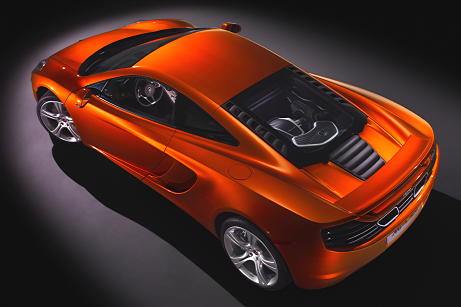McLaren claims class-leading performance for its MP4-12C road car. Here's my run-down of the specification highlights, comparing the £168,500 McLaren to two key rivals - Ferrari's 458 Italia (£173,132) and Lamborghini's Gallardo LP570-4 Superleggera e-Gear (£178,560)
Engine
Configuration: V8 twin-turbo, longitudinal
Dimensions: 3799cc, bore x stroke 92x69.9mm
Power: 600PS/592bhp at 7000rpm
Torque: 600Nm/443lbft at 3000-7000rpm
Ferrari: V8 normally aspirated, longitudinal; 4499cc; 570bhp at 9000rpm/398lbft at 6000rpm
Lamborghini: V10 normally aspirated, longitudinal; 5204cc; Power 562bhp at 8000rpm/398lbft at 6500rpm
The McLaren is the odd one out here. Instead of the big capacity, normally aspirated engines of the Italian pair the MP4-12C has a twin turbo V8 which gives away 700cc to the Ferrari and well over a litre to the Lamborghini but beats both for power and torque.
The McLaren's bespoke M838T engine is a 32-valve V8 with twin overhead camshafts per cylinder bank and variable timing on both intake and exhaust valves.
It develops 592bhp, 22bhp more the the Ferrari 458 Italia and 30bhp more than Lamborghini's most powerful Gallardo and provides 10% more torque than the Italian cars. Because that torque peak is available from 3000rpm to 7000rpm it should offer much greater flexibility and effortless performance.
Transmission
Type: 7-speed dual-clutch 'Seamless Shift Gearbox', rear-wheel drive
Ferrari: 7-speed dual-clutch gearbox, rear-wheel drive
Lamborghini: 6-speed E-Gear robotized manual gearbox, four-wheel drive
McLaren has gone the dual-clutch route, as has Ferrari for the 458 Italia. The best dual-clutch systems (like Porsche's PDK) provide rapid gear shifting and smooth automatic operation, but there are problems – dual-clutch transmissions are complex and heavy. Lamborghini, like Aston Martin, relies on a robotized manual transmission which offers similar benefits to the driver but is lighter and simpler.
The Lamborghini is the only one of the three with four-wheel drive, which should give it a traction advantage in acceleration away from rest.
Brakes
Type/size: Cast iron discs with forged aluminum hubs, 370mm front/350 mm rear
Braking distance 200km/h (124mph) to rest: 124m
Braking distance 100km/h (62mph) to rest: 30.5m
Ferrari: Brembo carbon ceramic discs, 398mm front/360mm rear, 200km/h-0: 128m, 100km/h-0: 32.5m
Lamborghini: Steel discs 365mm front/356mm rear, carbon ceramic option 380mm front/356mm rear, 200km/h-0 (steel discs): c128m
The Ferrari has bigger carbon ceramic brakes, but the McLaren has a performance advantage: according to both manufacturers' figures the McLaren stops shorter from 200km/h or 100km/h.
Lamborghini hasn't provided official braking figures, but the Gallardo braking performance is probably similar to the Ferrari.
Structure
Type: Carbon-fibre composite tub with aluminium alloy subframes front and rear
Dry weight: 1336kg
Ferrari: Bonded aluminium chassis, 1380kg
Lamborghini: Aluminium space frame, 1340kg
Every car McLaren has built in the last 30 years, whether for road or track, has had a carbon-fibre composite structure – and the MP4-12C is no different. What's new is that McLaren have been able to shave cost out of the manufacturing process, so it can sell a car with such an advanced, lightweight structure at a price competitive with the likes of Ferrari and Lamborghini.
The McLaren's dry weight is the lightest of these three, though only fractionally less than the Superleggera version of the (aluminium chassis) Gallardo. There is an optional lightweight spec for the MP4-12C which saves an extra 35kg.
Performance
Top speed: 205mph
0-62mph (100km/h): 3.3 seconds
0-124mph (200km/h): 9.1 seconds
Ferrari: over 202mph, 0-62mph: less than 3.4sec, 0-124mph: 10.4sec
Lamborghini: 202mph, 0-62mph: 3.4sec, 0-124mph: 10.2sec
All three a closely matched for top speed. Acceleration from rest to 100km/h is also similar for all three, despite the extra power and lower weight of the McLaren, or the four-wheel drive traction of the Lamborghini.
A track tyre option for the McLaren cuts the 0-100km/h time to 3.1 seconds, though similar tyre choice on the other cars would probably have a similar effect.
but at higher speeds the McLaren opens up a gap to the Italian cars – taking more than a second out of their 0-200km/h times.
Conclusions
Based on the manufacturers' specifications the McLaren appears to have an advantage in most areas – if only a fractional one in some cases.
Given the quality of McLaren's previous projects and its well known, fanatical, attention to detail, the MP4-12C is bound to drive well – just how well waits to be seen.
